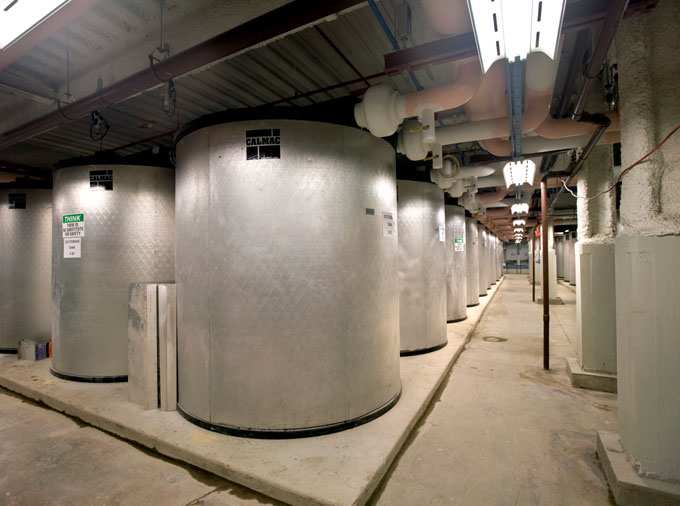Blog Post
Air Conditioning With Ice

Last week, we took a look at practical, easy-to-implement strategies for keeping our buildings cool during hot weather. This week, I'll describe a fascinating way to cool buildings using electricity at night to make ice. This isn't something most of us can run out and implement in our houses, but it's highly practical and cost-effective for many commercial buildings.
The technology is often referred to as "thermal energy storage" or TES. It's a practice most common in large commercial buildings, but at least one company is pursuing a residential market.
Here's how it works: At night, electricity is used to make ice. Most TES systems use "chillers" to cool an antifreeze solution that circulates through tubing in insulated tanks of water. Ice builds up on these submerged coils and by morning the whole tank is frozen.
Then, during the day, warm antifreeze solution is circulated through the same tubing. The surrounding ice cools it, and that chilled fluid either cools the building directly or is used to cool air that is distributed through ducts--like a standard central air conditioner.
There are two important ways that ice-based TES systems can save building owners--especially commercial building owners--a lot of money. First, customers with "time-of-day" pricing for electricity pay less for "off-peak" electricity at night. Most utility companies produce more electricity at night than they can sell, so they lower the price for commercial and industrial customers (occasionally also for residential customers). Thus, if these customers are able to shift electrical loads to nighttime hours, they save money.
Second, using a TES system for cooling can save money by reducing the peak electricity use during the daytime. Most commercial electricity customers pay two different charges on electric bills: they pay for the electricity they actually use (just as residential customers do), and they also pay a "demand charge" which is based on the company's peak electricity use. Utility companies charge this fee because they must have the generating capacity standing by in case it is called for. If an office building owner shifts a lot of the cooling load to the nighttime hours, consumption during the day (when electricity use for lighting and other functions is the greatest) will be reduced, lowering the building's peak demand.
SUPPORT INDEPENDENT SUSTAINABILITY REPORTING
BuildingGreen relies on our premium members, not on advertisers. Help make our work possible.
See membership options »Thermal energy storage systems offer another benefit that will become more important in the future: they will make it possible for us to obtain a higher fraction of our electricity from renewable energy sources. To understand why this is the case requires a bit of explanation:
If you're producing electricity from sunlight (using photovoltaic panels or solar-thermal power plants), the electricity is produced when demand for power is highest--during the daytime. But with most other renewable energy sources, such as wind, tidal, or wave power, a lot of the electricity will be produced when demand for electricity is low--such as at night.
This isn't much of an issue today, when we're only generating a tiny fraction of our electricity from these renewable energy sources. But if that fraction gets up to 20 or 30 percent, the disconnect between when the power is produced and when it's needed could be a real problem. (I addressed this issue in a past column about pumped-hydro storage.)
With TES systems, electricity use for cooling can be shifted to nighttime hours, so if offshore wind farms or tidal power plants are producing a lot of electricity at night, that power can be used productively to offset daytime electricity use.
Even if conventional electricity is used for TES systems, by consuming the electricity at night there is often--but not always--less pollution generated. This is because "peaking plants" are often dirtier than baseload power plants. Operating chillers and air conditioners to make ice at night can also be more energy-efficient than using that equipment during the day, because the outside air temperature is cooler and there's therefore less on-and-off cycling of the equipment.
Thousands of TES systems have been installed in commercial buildings throughout North America. I recently toured one in New York City's newest high rise office building (and the city's second-tallest building): the Bank of America Building at One Bryant Park, near Times Square. Three floors below ground level are 44 large insulated tanks made by Calmac Manufacturing where ice is produced each night; these satisfy about a quarter of the building's cooling demand.
Ice Energy, LLC (now Thule Energy Storage) makes a product called the Ice Bear 30 to provide this same sort of off-peak cooling on a smaller scale, including for homes (in the limited areas where they are available). It provides three to five tons of cooling (a ton of cooling is 12,000 Btus per hour) using a more standard compression-cycle air conditioning system. The ice is made and stored in an outdoor insulated box integrated with the compressor.
Ice-based thermal energy storage for commercial buildings is an example where both dollar savings and environmental benefits are achieved.
Published August 24, 2009 Permalink Citation
(2009, August 24). Air Conditioning With Ice. Retrieved from https://www.buildinggreen.com/blog/air-conditioning-ice



Add new comment
To post a comment, you need to register for a BuildingGreen Basic membership (free) or login to your existing profile.